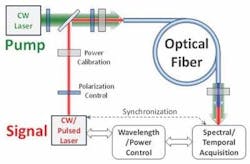500 GHz photon switch is based on subnanometer-scale-engineered optical fiber
Researchers at the University of California, San Diego have built the first 500 GHz photon switch, an approach made possible by advances in the control of a strong optical beam using only a few photons, and by the scientists' ability to engineer the optical fiber itself with accuracy down to the molecular level.1 In the experiment, a three-photon input was used to manipulate a watt-scale beam at a speed exceeding 500 GHz.
In addition to very fast beam control and fast switching, the latest work opens the way to a new class of sensitive receivers (also capable of operating at very high rates), faster photon sensors, and optical processing devices.
To build the new switch, the UC San Diego team developed a measurement technique capable of resolving subnanometer fluctuations in the fiber core size. This was critical because local fiber dispersion varies substantially, even with small core-size fluctuations, and until recently, control of such small variations was not considered feasible, particularly over long device lengths.
In their research, the engineers in the Photonic Systems Laboratory of UC San Diego's Qualcomm Institute demonstrated that fast control becomes possible in fiber made of silica glass. "Silica fiber represents a nearly ideal physical platform because of very low optical loss, exceptional transparency, and kilometer-scale interaction lengths," notes Stojan Radic, UC San Diego electrical and computer engineering professor.
Departing from conventional approaches that rely on highly resonant physical processes or optical cavities to control an optical beam directly, the UC San Diego team used specially designed highly nonlinear fibers. They came up with a way to measure core variations over lengths of fiber without doing damage to the fiber.
"We measured kilometers of fiber samples and recorded the core variations," says Nikola Alic, a research scientist in the Photonic Systems Laboratory. "The technique is so sensitive that if a fly landed on a fiber many miles away, it would distort the core ever so slightly and we could detect and measure it."
Nanoscale signature library
After measuring the fiber, the UC San Diego researchers were able to generate what they call a "nanoscale signature library." From there, they identified a specific core fluctuation profile that would correspond to the maximum depletion of the photon pump. Once the calculation yielded a unique core variation profile for a length of fiber, the scientists combined two distinct fiber sections from the core fluctuation library with the same variation profile.
They then figured out the efficiency and speed of few-photon control. They were able to estimate the minimum number of photons in the control pulse permitted by the specific fiber. The resulting 2.5-picosecond-long pulse, with a peak power of 178 nW, contained less than three photons, indicating the feasibility of few-photon switching at a 500 GHz rate.
To take full advantage of photon switching, says Radic, a new class of fibers is needed—fibers in which the fluctuation of stochastic (randomly determined) dispersions could be minimized. These must be engineered fibers, and the UC San Diego team has already built a first prototype of a fiber engineered for this purpose.
Source: http://ucsdnews.ucsd.edu/pressrelease/uc_san_diego_researchers_build_first_500_ghz_photon_switch
REFERENCE:
1. R. Nissim et al., Science, pp. 417-419, Vol. 345, Issue 6195, 25 July 2014; doi: 10.1126/science:1253125
About the Author
John Wallace
Senior Technical Editor (1998-2022)
John Wallace was with Laser Focus World for nearly 25 years, retiring in late June 2022. He obtained a bachelor's degree in mechanical engineering and physics at Rutgers University and a master's in optical engineering at the University of Rochester. Before becoming an editor, John worked as an engineer at RCA, Exxon, Eastman Kodak, and GCA Corporation.

